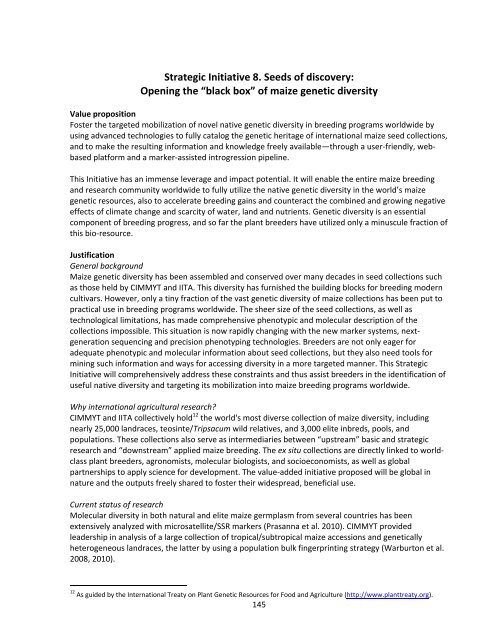Download - Maize
Download - Maize
Download - Maize
Create successful ePaper yourself
Turn your PDF publications into a flip-book with our unique Google optimized e-Paper software.
Strategic Initiative 8. Seeds of discovery:<br />
Opening the “black box” of maize genetic diversity<br />
Value proposition<br />
Foster the targeted mobilization of novel native genetic diversity in breeding programs worldwide by<br />
using advanced technologies to fully catalog the genetic heritage of international maize seed collections,<br />
and to make the resulting information and knowledge freely available—through a user‐friendly, webbased<br />
platform and a marker‐assisted introgression pipeline.<br />
This Initiative has an immense leverage and impact potential. It will enable the entire maize breeding<br />
and research community worldwide to fully utilize the native genetic diversity in the world’s maize<br />
genetic resources, also to accelerate breeding gains and counteract the combined and growing negative<br />
effects of climate change and scarcity of water, land and nutrients. Genetic diversity is an essential<br />
component of breeding progress, and so far the plant breeders have utilized only a minuscule fraction of<br />
this bio‐resource.<br />
Justification<br />
General background<br />
<strong>Maize</strong> genetic diversity has been assembled and conserved over many decades in seed collections such<br />
as those held by CIMMYT and IITA. This diversity has furnished the building blocks for breeding modern<br />
cultivars. However, only a tiny fraction of the vast genetic diversity of maize collections has been put to<br />
practical use in breeding programs worldwide. The sheer size of the seed collections, as well as<br />
technological limitations, has made comprehensive phenotypic and molecular description of the<br />
collections impossible. This situation is now rapidly changing with the new marker systems, nextgeneration<br />
sequencing and precision phenotyping technologies. Breeders are not only eager for<br />
adequate phenotypic and molecular information about seed collections, but they also need tools for<br />
mining such information and ways for accessing diversity in a more targeted manner. This Strategic<br />
Initiative will comprehensively address these constraints and thus assist breeders in the identification of<br />
useful native diversity and targeting its mobilization into maize breeding programs worldwide.<br />
Why international agricultural research?<br />
CIMMYT and IITA collectively hold 12 the world's most diverse collection of maize diversity, including<br />
nearly 25,000 landraces, teosinte/Tripsacum wild relatives, and 3,000 elite inbreds, pools, and<br />
populations. These collections also serve as intermediaries between “upstream” basic and strategic<br />
research and “downstream” applied maize breeding. The ex situ collections are directly linked to worldclass<br />
plant breeders, agronomists, molecular biologists, and socioeconomists, as well as global<br />
partnerships to apply science for development. The value‐added initiative proposed will be global in<br />
nature and the outputs freely shared to foster their widespread, beneficial use.<br />
Current status of research<br />
Molecular diversity in both natural and elite maize germplasm from several countries has been<br />
extensively analyzed with microsatellite/SSR markers (Prasanna et al. 2010). CIMMYT provided<br />
leadership in analysis of a large collection of tropical/subtropical maize accessions and genetically<br />
heterogeneous landraces, the latter by using a population bulk fingerprinting strategy (Warburton et al.<br />
2008, 2010).<br />
12 As guided by the International Treaty on Plant Genetic Resources for Food and Agriculture (http://www.planttreaty.org).<br />
145

















